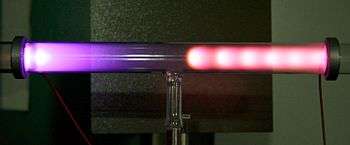Ionization instability
An ionization instability is any one of a category of plasma instabilities which is mediated by electron-impact ionization. In the most general sense, an ionization instability occurs from a feedback effect, when electrons produced by ionization go on to produce still more electrons through ionization in a self-reinforcing way.
Ionization instabilities have been seen in such plasma physics apparatus as glow discharges,[1][2] Penning discharges,[3] magnetic nozzles,[4][5][6] and MHD generators.[7][8][9] Ionization instabilities may occur in magnetized or unmagnetized[10] plasma. They occur mostly when the plasma is relatively cold and only partially ionized, so that there is a lot of neutral gas mixed in with the plasma.
In a glow discharge

A glow discharge is a plasma-containing apparatus in which the plasma is formed by a large voltage placed across a rarefied gas. Glow discharges are used for electric lighting and materials processing. In a glow discharge, ionization instability takes the form of striations,[1] or bands of enhanced and suppressed light production. The distance between each striation is the distance required for an electron to gain enough energy to ionize a neutral gas particle.
In a magnetic nozzle
A magnetic nozzle is an apparatus through which plasma flows, in which the plasma is constricted by a magnetic field. Magnetic nozzles are used in electric propulsion to enhance the thrust produced by a stream of plasma. In magnetic nozzles, ionization instability is caused by ionization downstream of the nozzle, causing electrons born there to migrate upstream, counter to the direction of flow. This causes the plasma flow rate and energy through the nozzle to oscillate.[4][5][6]
In an MHD generator
An MHD generator is an apparatus through which hot gas flows, in which the gas is ionized and a magnetic field is used to extract flow energy as electrical energy. MHD generators were studied mostly in the 1960s and 1970s to increase the efficiency of fossil-fueled and nuclear-fission power plants.[11] In MHD generators, the specific kind of magnetized ionization instability is called the electrothermal instability. It was discovered by Evgeny Velikhov in 1962. The added electrical resistance caused by ionization instability thwarted a research effort to lower the required temperature by heating electrons preferentially.[11]
References
- Garscadden, A. (1969). "Dispersion and Stability of Moving Striations". Physics of Fluids. 12 (9): 1833. Bibcode:1969PhFl...12.1833G. doi:10.1063/1.1692748. ISSN 0031-9171.
- Allis, W.P. (1976-03-01). "Review of glow discharge instabilities". Physica B+C. 82 (1): 43–51. Bibcode:1976PhyBC..82...43A. doi:10.1016/0378-4363(76)90267-9. ISSN 0378-4363.
- Roth, J. Reece (1969). "Experimental Observation of Low-Frequency Oscillations Described by the Plasma Continuity Equations". Physics of Fluids. 12 (1): 260. Bibcode:1969PhFl...12..260R. doi:10.1063/1.1692284. ISSN 0031-9171.
- Johnson, J. C.; D'Angelo, N; Merlino, R. L. (1990). "A double layer induced ionisation instability". Journal of Physics D: Applied Physics. 23 (6): 682–685. Bibcode:1990JPhD...23..682J. doi:10.1088/0022-3727/23/6/007.
- Aanesland, A.; Charles, C.; Lieberman, M. A.; Boswell, R. W. (18 August 2006). "Upstream Ionization Instability Associated with a Current-Free Double Layer". Physical Review Letters. 97 (7): 075003. Bibcode:2006PhRvL..97g5003A. doi:10.1103/physrevlett.97.075003. ISSN 0031-9007. PMID 17026239.
- Aanesland, A.; Lieberman, M. A.; Charles, C.; Boswell, R. W. (December 2006). "Experiments and theory of an upstream ionization instability excited by an accelerated electron beam through a current-free double layer". Physics of Plasmas. 13 (12): 122101. Bibcode:2006PhPl...13l2101A. doi:10.1063/1.2398929. hdl:1885/16395. ISSN 1070-664X.
- KERREBROCK, J. L. (July 1964). "Nonequilibrium ionization due to electron heating - i - theory". AIAA Journal. 2 (6): 1072–1080. Bibcode:1964AIAAJ...2.1072K. doi:10.2514/3.2496. ISSN 0001-1452.
- Murakami, Tomoyuki; Okuno, Yoshihiro; Yamasaki, Hiroyuki (9 May 2005). "Suppression of ionization instability in a magnetohydrodynamic plasma by coupling with a radio-frequency electromagnetic field". Applied Physics Letters. 86 (19): 191502. Bibcode:2005ApPhL..86s1502M. doi:10.1063/1.1926410. ISSN 0003-6951.
- Velikhov, E. P., A. M. Dykhne, and I. Ya. Shipuk. “Ionization Instability of a Plasma with Hot Electrons.” From the 5th Symposium on the Ionization of Gases, Yugoslavia, 1965. https://ntrs.nasa.gov/archive/nasa/casi.ntrs.nasa.gov/19670016557.pdf.
- Akhiezer, A. I.; Akhiezer, A. I.; Angeleiko, V. V. (1969). "A New Kind of Instability in a Partially Ionized Plasma". Soviet Journal of Experimental and Theoretical Physics. 30: 476. Bibcode:1969JETP...30..476A.
- Harris, L. P.; Moore, G. E. (1971). "Combustion-MHD Power Generation for Central Stations". IEEE Transactions on Power Apparatus and Systems. 90 (5): 2030. Bibcode:1971ITPAS..90.2030H. doi:10.1109/TPAS.1971.292998.